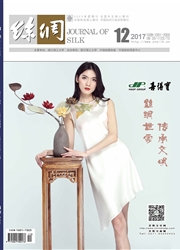

 中文摘要:
中文摘要:
使用木瓜蛋白酶在非离子型反胶束体系中对蚕丝纤维进行脱胶处理,重点研究脱胶时间、脱胶温度、蛋白酶质量浓度及反胶束体系中增溶水量等因素对蚕丝脱胶率的影响。使用生物显微镜对脱胶蚕丝的表面形态进行观察,并考察和比较酸性黑234对脱胶前后蚕丝纤维的染色性能。结果表明,在反胶束体系中生物蛋白酶对蚕丝纤维的脱胶过程需120 min左右,蚕丝脱胶率随着生物酶质量浓度的增加而增大,在增溶水量为10的50℃反胶束体系中蚕丝的脱胶率达到最大值,并且酸性染料对经反胶束体系脱胶后的蚕丝纤维具有更高的染色性能。
 英文摘要:
英文摘要:
Papain is used to conduct degumming treatment of silk fiber in non-ionic reverse micelle system. This paper mainly studies the effects of the time and temperature of degumming,mass concentration of protease and solubilizing water in reverse micelle system on silk degumming rate. Biological microscope is used to observe the surface morphology of silk. Besides,this paper inspects and compares dyeing property of acid black 234 on silk fiber before and after degumming treatment. The results show,in reverse micelle system,the degumming process time of biological protease on silk fiber is about 120 min. Silk degumming rate increases with the rise in the mass concentration of bio-enzyme; the degumming rate reaches the maximum under such conditions as: solubilizing water volume 10; temperature 50℃; reverse micelle system. In addition,acid dyes have higher dyeing property on silk fiber after degumming with reverse micelle.
 同期刊论文项目
同期刊论文项目
 同项目期刊论文
同项目期刊论文
 期刊信息
期刊信息
